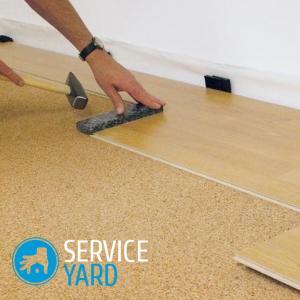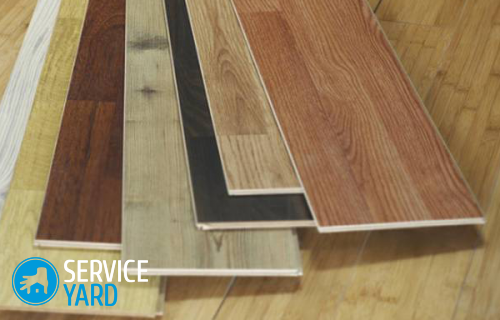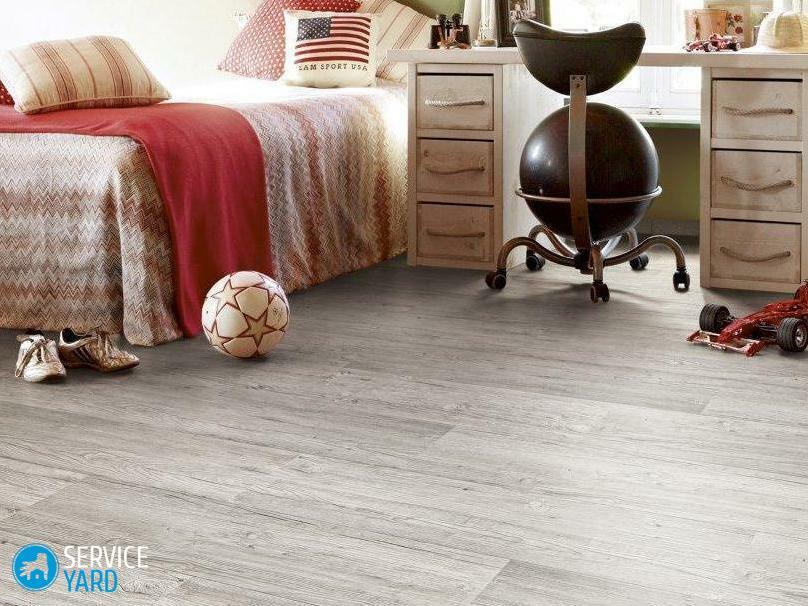
- Advantages and disadvantages of
- laminate What is it made of?
- Laminate. Classes - how to choose?
- Is thickness and density important?
- Adhesive or lock?
- To laminate has long
Laminate in recent decades has become, perhaps, the most popular floor covering. Flooring it is easy, caring for it - even easier, and the range is so great that you can with minimal effort create an interior in any style. But before you start repair, you need to choose the right materials. And to begin best with the answer to the question, how to choose a laminate. About what kinds of laminate are available, their advantages and disadvantages will be discussed in the article.
to content ↑Advantages and disadvantages of
laminate As compared to other coatings, the laminate has a lot of advantages:
- Any owner can build floors by having his hands grow from "the right place".
- Laminate has excellent thermal insulation properties, that is, the apartment will always be warm.
- This kind of coating with a proper care is very long.
- As a rule, laminate is made of neutral materials that do not harm the environment and occupants of the apartment.
- Among other things, laminate flooring will allow you to give vent to fantasy and create something from an ordinary apartment that is interesting and unusual.
Important! The disadvantages can be attributed to the fact that the laminate does not like water. But this property can also be translated into the category of merits - there will be less temptations to wash floors with a lot of water, as is usually done in apartments where linoleum is laid.
to the contents ↑What is it made of?
Before you go to the store, it is better to learn something about what you are going to buy. To choose the laminate correctly, you need to understand how it is arranged. This material always consists of several layers:
- overlay, the same top layer - transparent acrylic film;
- decorative layer - the one where the drawing;
- middle layer - the thickest, affects the heat-shielding properties;
- the bottom layer is a substrate that serves to protect the medium.
Overlay
Acrylic resin, from which the top layer is made, allows the material not to wear off from mechanical influences. Mechanical damage to the floor happens even in the apartment, where everyone walks in soft slippers. In addition, the overlay protects the decorative layer from burning out, which is especially important for solar apartments. It also has antistatic properties - in a word, there are many functions in this layer, despite the fact that it is rather thin - only about a millimeter.

Decorative layer
Decorative layer for strength and durability does not affect, but it depends on it, what will your apartment look like. It is usually made of paper with a pattern "for parquet", "marble", etc. Here you will have to choose the laminate yourself, based on your preferences and the planned style of the interior.
Medium layer
The properties of the middle layer, basically, determine the quality of the laminate. Depend on it directly and depend on strength, and durability, and environmental friendliness. The middle layer is a plate made of fiberboard or chipboard.
Important! If on the label you see the word "moisture-proof", this means the plate is made not from wood chips, but from special plastic, or plastic is added to the shavings. The thickness of the middle layer is about 10 mm.
Bottom layer
Bottom layer is needed to ensure that the substrate is not exposed to unnecessary influences. In addition, it has soundproofing properties, which is especially important for modern apartments with their "cardboard" walls.
It is made of resin-impregnated paper, foamed polyethylene is used to improve the soundproofing properties, sometimes - a stopper, polystyrene, aluminum foil.
to the table of contents ↑Laminate. Classes - how to choose?
Manufacturers and serious trading companies use the so-called taber test consisting of eighteen stages to determine the quality of the laminate. As a result of such checks, it is determined:
- what mechanical loads can withstand this or that kind of laminate;
- what substances are capable of destroying it;
- does not emit any harmful substances under the influence of detergents or light.
This is a rather lengthy procedure, which is hardly necessary for anyone who wants to buy a laminate for their apartment. If you started repairing and you want to overhaul the floors, you need to know only the laminate classes. There are six of them.
Important! Sometimes you can see the marking "34" - this means that you have a heavy-duty laminate with increased durability.
Class designation consists of two digits, the first of which indicates for which rooms this material is intended.
- Two means that the laminate is intended for residential use.
- The triple labeled laminate for public buildings.
Important! The figure "3" does not at all mean that laminate can not be used in apartments. Just for public buildings, the material should be thicker and stronger.
The second digit is 1, 2 or 3. On it you can find out the thickness of the laminate and how much it is resistant to wear and mechanical influences.
Laminate for public buildings
This category includes laminates of the following classes:
- 33;
- 32;
- 31.
What to choose, which laminate to choose?- Determine the properties of each option:
- The most durable laminate flooring is class 33. It is floored in rooms where there are usually a lot of people. It is resistant to abrasion, to mechanical stress and must last at least twenty years. Such material can be used in an apartment, the whole question is whether it is necessary. As a rule, such a laminate is more expensive than all others.
- Laminates 32 and 32 classes are also intended primarily for public buildings, but they are used most often where there is not a large crowd of people and high traffic. These are quite worthy materials that can serve several decades, but they have a lower wear resistance than 33.
Laminates for living areas
After thinking about how to choose a good laminate for an apartment, first decide which room you are going to use for floors. Typically, for the repair of apartments choose a laminate, the marking of which begins with the number "2".It is less durable than the material for public buildings, but it is much cheaper.
You can find on sale laminates of classes:
- 23;
- 22;
- 21.

For the hallway and kitchen
Visitors in the hallway are the most. This is the owners of the apartment, and the guests, who then disperse to different rooms, and casual visitors like plumbers, electricians or doctors. People enter the hallway in the street shoes. Therefore, the laminate should be stronger than in rooms with more sparing conditions.
Important! For the hallway the laminate with the marking "23" is most suitable.
As far as the kitchen is concerned, there are also no harmful influences in this room, so the most durable of the "apartment laminates" will be very handy.
Important! Material of the same class is suitable for bathroom and toilet, as well as for walk-through rooms.
Two-piece and
laminate Class 22 or 21 laminate is not suitable for all premises. Of course, it is cheaper than the others, however, the hassle with it will be immeasurably greater, and it does not last long.
Where should I use it?- The options are:
- It can be laid, for example, in a nursery - in a few years the child will grow up, a cheerful figure with bunnies or football balls will not like it, and the floor still has to be repaired.
- Laminate of this class is suitable for the living room, especially if repairs have become a part of your life and you like to change the interior often. This is the cheapest laminate, so it's not a shame to change it.
Is Thickness and Density Important?
Asking the question how to choose a quality laminate, pay attention to two more criteria:
- thickness;
- density.
They are important not only to ensure good sound insulation or to make the floor warm. The strength of this material depends on the thickness.
Important! The thickness of the laminate, which you can find in building stores, varies from 6 to 12 mm. And the choice is simple - the thicker, the better.
Density can sometimes be estimated from the marking of the board. This applies to the middle layer, that is, the base layer. Marking depends on the manufacturer:
- NDF - European and American manufacturers;
- MDF - Russian manufacturers.
The plate with NDF marking has a higher density, respectively - higher strength and durability.
On the packaging most often is the density of the material, expressed in figures. If the laminate is of high quality, it will be more than 850 kg / m3
Important! The density of the laminate, if it is not indicated on the marking, can be calculated by yourself. Weight is indicated on the package. You need to divide it into volume - that is, you need to multiply the area of all the boards by the thickness.
Other designations
You can find other symbols on the label. For example, the following:
- HPL;
- CPL;
- DPL.
What do they mean?- The manufacturing method, which also affects the final properties of the material:
- The laminate with HPL marking is made under high pressure - at first the top layer is pressed with decorative, then all this is glued to the substrate, fastened to the substrate and pressed again, all together. This is a very high-quality, but also very expensive material.
- CPL marking means that the laminate was made with a belt press at a lower pressure than the previous one. This is the most popular material when the price is in harmony with quality.
- The cheapest laminates are marked DPL.In the production of this material, all layers are pressed simultaneously. Since the cost price is usually low, then the price in stores is acceptable, so that the laminate with such markings is very much in demand, despite the fact that it is inferior in quality to the first two.
Adhesive or lock?
When buying a laminate, you need to take into account and such criteria, as the method of mounting panels. There are two:
- glue;
- lock.
Each of them has its advantages and disadvantages. With glued joints, the panels are glued together. With the lock - on each panel there are fastening elements.
Advantages of glutinous technology
Advantages of adhesive mounting method are undeniable:
- wear resistance;
- longevity;
- cheap;
- no exposure to moisture.
Cons
But there are a number of drawbacks:
- such panels are difficult to mount independently, you need the help of a specialist;
- for the "underfloor" system such panels are not suitable;
- if one panel fails - the floor will have to be shifted completely.
Advantages of locks
Advantages of the lock method.
- can replace any panel.
- lay this laminate can be quickly and easily.
- helper for installation is optional.
Cons
Disadvantages of these panels are that:
- they are more expensive than glue;
- moisture may enter the joints;
- panels serve less than those with glue fastening.
Important! In addition, before choosing a lock type laminate, note that the fasteners may also be different.
- lok;
- click.
In the first case, the panels are driven one into the other, in the second - at the ends there are special fasteners that snap into place. Laminate type lok is usually cheaper.
to the contents ↑To laminate served long
The main enemies of the laminate are mud and water. Unfortunately, the dirt in the apartments is constantly being recorded. Therefore, care should be regular. What will it include?- You do not have to carry out any super complicated measures:
- The first tool that will save your floors is a mat at the door. It must be cleaned regularly.
- Not all kinds of laminate tolerate moisture well. Therefore, if you can not afford a moisture-resistant laminate flooring and you chose a relatively cheap one, forget about washing the floors. In this case, you get a vacuum cleaner, just take care of the special nozzle.
- If you have a moisture-resistant laminate - wash it with detergent is also not worth it. In the hardware store, you can easily find a tool designed specifically for this type of coating, and instructions for use are always on the packaging.
Now you not only have an idea of what laminate classes are and how to choose it correctly, but also know how to care for it in order to preserve the original properties of the coating. We hope you not only managed to buy inexpensive and high-quality laminate, but you were able to make your own laying with your own hands, which means you got a double moral pleasure from the appearance of your house.
